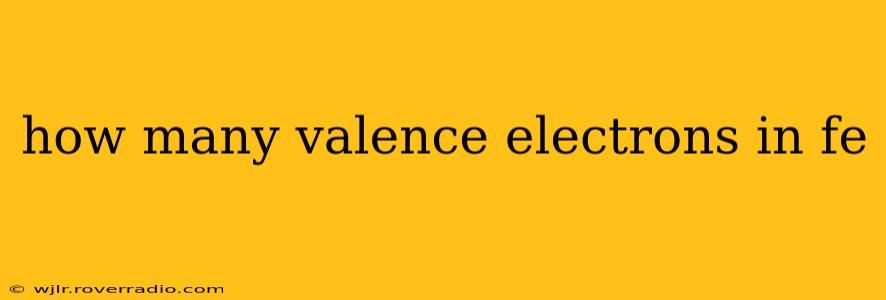Iron (Fe), a crucial element in biology and industry, presents a slightly nuanced answer regarding its valence electrons. Unlike elements with straightforward valence electron configurations, iron's behavior is more complex due to its position in the periodic table and the involvement of its d-orbitals.
Let's explore this in detail.
What are Valence Electrons?
Before diving into iron's specifics, it's essential to understand the concept of valence electrons. These are the electrons located in the outermost shell of an atom. They are the electrons involved in chemical bonding and determine an element's reactivity.
Iron's Electron Configuration and Valence Electrons
Iron has an atomic number of 26, meaning it has 26 electrons. Its electron configuration is [Ar] 3d⁶ 4s². This configuration is key to understanding its valence electron behavior.
While the 4s² electrons are the outermost electrons, and usually considered valence electrons in simpler cases, iron's 3d electrons also play a significant role in its chemistry, particularly in its ability to form multiple oxidation states.
Therefore, depending on the context, the number of valence electrons in iron can be considered:
- Two: In some instances, only the 4s² electrons are considered valence electrons. This is a simplification.
- Eight: In other instances, both the 4s² and 3d⁶ electrons can participate in bonding, leading to a consideration of eight valence electrons. This is more accurate when considering iron's diverse chemistry.
Why the Variation?
The variability arises because the energy difference between the 3d and 4s orbitals is relatively small. This allows for electrons to be easily promoted from the 3d orbital to the 4s orbital, or vice-versa, during chemical reactions, leading to multiple oxidation states (like +2 and +3).
What about Iron's Oxidation States?
The concept of valence electrons is closely tied to the oxidation state of an element. Iron commonly exhibits +2 (ferrous) and +3 (ferric) oxidation states. This stems from the varying involvement of its 3d and 4s electrons in chemical bonding.
How Many Valence Electrons Does Iron Have in Different Compounds?
The number of valence electrons isn't a fixed value for iron; it depends on the specific compound it forms. For example, in FeCl₂, iron is in the +2 oxidation state, implying that two electrons are involved in the bonding (likely the two 4s electrons). However, in FeCl₃, iron is in the +3 oxidation state, signifying three electrons participating in the bonding (potentially two from 4s and one from 3d).
Conclusion
In summary, while a simplistic view might suggest two valence electrons for iron (based on the 4s² electrons), a more comprehensive understanding considers the involvement of the 3d electrons as well, leading to a possible total of eight valence electrons. The actual number depends heavily on the specific chemical context and the oxidation state of iron in the compound. Iron's versatility in chemical bonding highlights the importance of considering its d-electrons alongside the s-electrons when analyzing its valence electron count.
